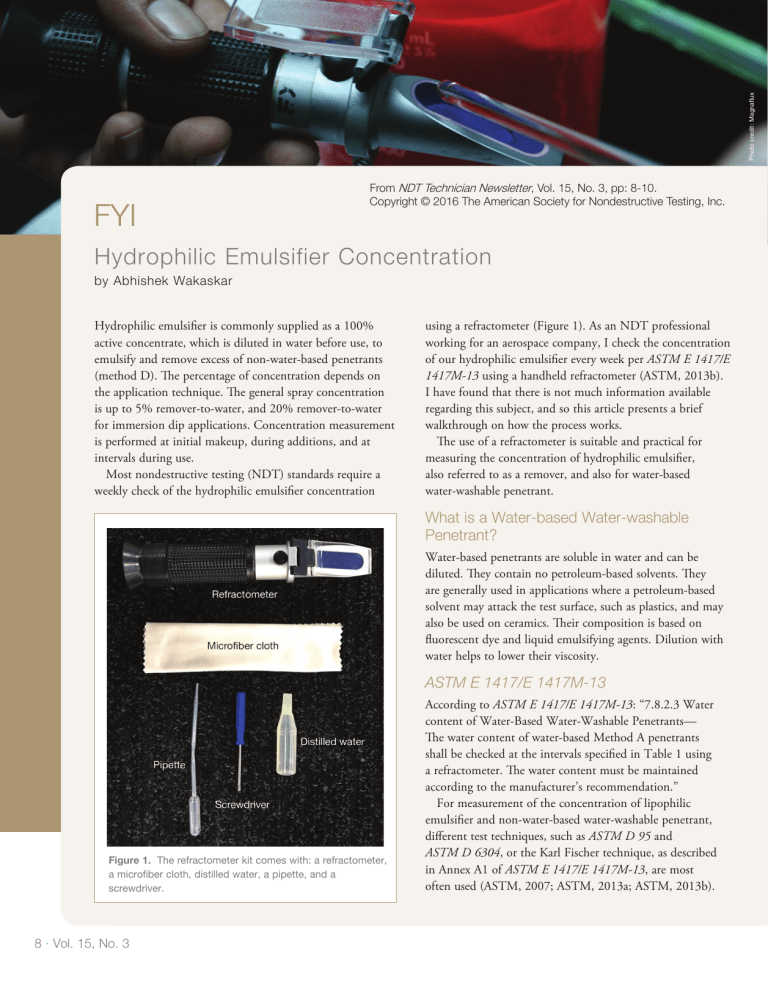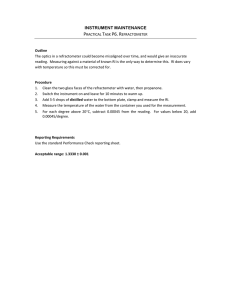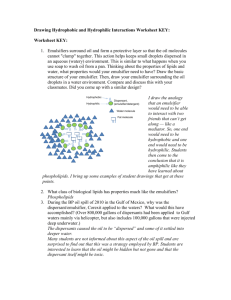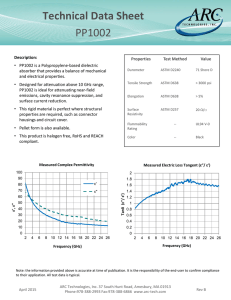
Photo credit: Magnaflux FYI From NDT Technician Newsletter, Vol. 15, No. 3, pp: 8-10. Copyright © 2016 The American Society for Nondestructive Testing, Inc. Hydrophilic Emulsifier Concentration by Abhishek Wakaskar Hydrophilic emulsifier is commonly supplied as a 100% active concentrate, which is diluted in water before use, to emulsify and remove excess of non-water-based penetrants (method D). The percentage of concentration depends on the application technique. The general spray concentration is up to 5% remover-to-water, and 20% remover-to-water for immersion dip applications. Concentration measurement is performed at initial makeup, during additions, and at intervals during use. Most nondestructive testing (NDT) standards require a weekly check of the hydrophilic emulsifier concentration using a refractometer (Figure 1). As an NDT professional working for an aerospace company, I check the concentration of our hydrophilic emulsifier every week per ASTM E 1417/E 1417M-13 using a handheld refractometer (ASTM, 2013b). I have found that there is not much information available regarding this subject, and so this article presents a brief walkthrough on how the process works. The use of a refractometer is suitable and practical for measuring the concentration of hydrophilic emulsifier, also referred to as a remover, and also for water-based water-washable penetrant. What is a Water-based Water-washable Penetrant? Water-based penetrants are soluble in water and can be diluted. They contain no petroleum-based solvents. They are generally used in applications where a petroleum-based solvent may attack the test surface, such as plastics, and may also be used on ceramics. Their composition is based on fluorescent dye and liquid emulsifying agents. Dilution with water helps to lower their viscosity. ASTM E 1417/E 1417M-13 Figure 1. The refractometer kit comes with: a refractometer, a microfiber cloth, distilled water, a pipette, and a screwdriver. 8 · Vol. 15, No. 3 According to ASTM E 1417/E 1417M-13: “7.8.2.3 Water content of Water-Based Water-Washable Penetrants— The water content of water-based Method A penetrants shall be checked at the intervals specified in Table 1 using a refractometer. The water content must be maintained according to the manufacturer’s recommendation.” For measurement of the concentration of lipophilic emulsifier and non-water-based water-washable penetrant, different test techniques, such as ASTM D 95 and ASTM D 6304, or the Karl Fischer technique, as described in Annex A1 of ASTM E 1417/E 1417M-13, are most often used (ASTM, 2007; ASTM, 2013a; ASTM, 2013b). What is a Refractometer? A refractometer is an optical device that measures the refractive index of a liquid. This value increases in proportion to the dissolved solids in the liquid and hence is used to measure the concentration of hydrophilic emulsifier and water-based water-washable penetrants. What is Determined by the Concentration? The following are determined by the concentration: l The quantity of emulsifier to be added to compensate for changes in the concentration during use. l The sensitivity and performance of the emulsifier. l The amount of contact time required to remove the surface penetrant. l The economies of its use reducing excess use of emulsifier. In this walkthrough, I will measure the concentration of hydrophilic emulsifier or remover diluted in water using a handheld refractometer. Note: non-standard temperatures and contamination by liquid penetrant can cause the refractive index to shift, resulting in false values. The refractometer in this example uses a Brix scale. The Brix scale was designed to measure sugar and water mixtures. Therefore, it is imperative to create a chart (Figure 2) to establish a correction. In this case, we want the concentration to not exceed 5%. Figure 3. Prism onto which drops of distilled or reverse osmosis water should be added. bubbles. Once that happens, wait 30 s for the sample to stay on the prism. Then look through the eyepiece and adjust the calibration screw until the light/dark boundary coincides with the null line (Figure 4). Note: adjustment should be done at an environmental temperature of 20 °C (68 °F). In the case of our refractometer, which is provided with an automated temperature compensation function, the correction of temperature is not needed. Figure 2. Concentration control Brix refractometer scale (0–32). So, we create mixtures of: 1 part emulsifier to 25 parts water (4%), 1 part emulsifier to 20 parts water (5%), and 1 part emulsifier to 50 parts water (2%). The concentration is controlled using a Brix refractometer and a concentration chart. Based on the chart, a refractive index reading of 1 will actually be a concentration level of 2% emulsifier. Method of Operation Adjustment to zero (null): place two to three drops of distilled or reverse osmosis water on the refractometer’s main prism (Figure 3). The water must spread across the surface of the prism without any Figure 4. Through the eyepiece we can see that the scale reads zero (that is, calibrated to null). TNT · July 2016 · 9 FYI | Hydrophilic Emulsifier Concentration As per ASTM E 1417/E 1417M-13, for spraying applications, the maximum concentration allowed is 5%. In this case, since the sample reads 4% (Figure 5) with the corrected reading of 1% (referring to the correction chart), it would be 5%, which means it is good for spraying applications. Note: too much emulsifier concentration will cause all of the penetrant to be removed from the part, even the discontinuities, and will require a complete reapplication of penetrant. On the other hand, too little emulsifier concentration will cause excessive background florescence. The solution is simple, that is, add more emulsifier to the mixture if the concentration is too low or add more water to the mixture if the concentration is too high. h AUTHOR Abhishek Wakaskar: ASNT NDT Level III; Aerospace Precision, Inc., 2851 Evans St., Hollywood, Florida 33020; (954) 923-3213; fax (954) 923-3223. Figure 5. Through the eyepiece we can see that the scale reads 4%. Now that the refractometer calibration is complete, measure the emulsifier sample in the same manner as for calibration. Clean the prism using a microfiber cloth. Add two to three drops of emulsifier onto the prism, again making sure that the emulsifier spreads evenly across the surface without any bubbles and wait for 30 s. Then look through the eyepiece and read the corresponding scale on the light/dark boundary. REFERENCES ASTM, ASTM D 6304, Standard Test Method for Determination of Water in Petroleum Products, Lubricating Oils, and Additives by Coulometric Karl Fischer Titration, ASTM International, West Conshohocken, Pennsylvania, 2007. ASTM, ASTM D 95, Standard Test Method for Water in Petroleum Products and Bituminous Materials by Distillation, ASTM International, West Conshohocken, Pennsylvania, 2013a. ASTM, ASTM E 1417/E 1417M-13, Standard Practice for Liquid Penetrant Testing, ASTM International, West Conshohocken, Pennsylvania, 2013b.



